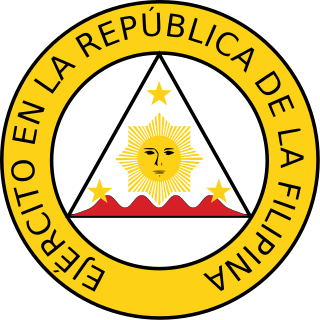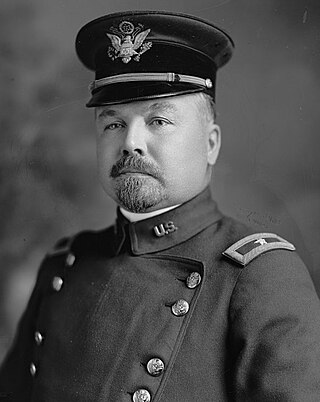Related Research Articles

The Philippine Revolutionary Army, later renamed Philippine Republican Army, was the official armed forces of the First Philippine Republic from its formation in March 1897 to its dissolution in November of 1899 in favor of guerrilla operations in the Philippine–American War.

The Philippine–American War, known alternatively as the Philippine Insurrection, Filipino–American War, or Tagalog Insurgency, was fought between the First Philippine Republic and the United States from February 4, 1899, until July 2, 1902. Tensions arose after the United States annexed the Philippines under the Treaty of Paris at the conclusion of the Spanish–American War rather than acknowledging the Philippines' declaration of independence. The war can be seen as a continuation of the Philippine struggle for independence that began in 1896 with the Philippine Revolution against Spanish rule.

Frederick Funston, also known as Fighting Fred Funston, was a general in the United States Army, best known for his roles in the Spanish–American War and the Philippine–American War; he received the Medal of Honor for his actions during the latter conflict.

Samar is the third-largest and seventh-most populous island in the Philippines, with a total population of 1,909,537 as of the 2020 census. It is located in the eastern Visayas, which are in the central Philippines. The island is divided into three provinces: Samar, Northern Samar, and Eastern Samar. These three provinces, along with the provinces on the nearby islands of Leyte and Biliran, are part of the Eastern Visayas region.

Elwell Stephen Otis was a United States Army general who served in the American Civil War, Indian Wars, the Philippines late in the Spanish–American War and during the Philippine–American War.

The Battle of Zapote River, also known as the Battle of Zapote Bridge, was fought on the 13 June 1899 between 1,200 Americans and between 4,000~5,000 Filipinos. It was the second largest battle of the Philippine–American War after the Battle of Manila five months before in February 1899. Zapote River separates the town of Las Piñas in what was then Manila province from Bacoor in the province of Cavite. The ruins of Zapote Bridge still stands next to its replacement bridge on Aguinaldo Highway.

The Battle of Manila, the first and largest battle of the Philippine–American War, was fought on February 4–5, 1899, between 19,000 American soldiers and 15,000 Filipino armed militiamen. Armed conflict broke out when American troops, under orders to turn away insurgents from their encampment, fired upon an encroaching group of Filipinos. Philippine President Emilio Aguinaldo attempted to broker a ceasefire, but American General Elwell Stephen Otis rejected it, and fighting escalated the next day. It ended in an American victory, although minor skirmishes continued for several days afterward.

This Battle of Santa Cruz was fought in the early stages of the Philippine–American War during General Henry W. Lawton's Laguna de Bay campaign.
The Philippine–American War, also known as the Philippine War of Independence or the Philippine Insurrection (1899–1902), was an armed conflict between Filipino revolutionaries and the government of the United States which arose from the struggle of the First Philippine Republic to gain independence following the Philippines being acquired by the United States from Spain. This article lists significant events from before, during, and after that war, with links to other articles containing more detail.

The Philippine Republic, now officially remembered as the First Philippine Republic and also referred to by historians as the Malolos Republic, was established in Malolos, Bulacan during the Philippine Revolution against the Spanish Empire (1896–1898) and the Spanish–American War between Spain and the United States (1898) through the promulgation of the Malolos Constitution on January 22, 1899, succeeding the Revolutionary Government of the Philippines. It was formally established with Emilio Aguinaldo as president. It maintained governance until April 1, 1901.

The Society for Military History is a United States–based international organization of scholars who research, write, and teach military history of all time periods and places. It includes naval history, air power history, and studies of technology, ideas, and homefronts. It publishes the quarterly refereed The Journal of Military History.
The 1st Separate Brigade (Philippine Expedition), United States Army was a U.S. expeditionary brigade. It was commanded by Brigadier General Marcus P. Miller consisted of the 18th U.S. Infantry Regiment, 51st Iowa Infantry Regiment and a battery of 6th Artillery. It was organised to provide a U.S. Army expeditionary force for the Philippine campaign of the Spanish–American War.
Robert W. Griffith was an American historian.

John Wilson Ruckman was a major general in the United States Army.

The battle of Caloocan was one of the opening engagements of the Philippine–American War, and was fought between a U.S. force under the command of Arthur MacArthur Jr. and Filipino defenders commanded by Antonio Luna in 1899. American troops launched a successful attack on the Filipino-held settlement of Caloocan on February 10, which was part of an offensive planned by MacArthur Jr. Coming soon after an American victory near Manila just a few days prior, the battle once again demonstrated the military superiority enjoyed by U.S. forces over Filipino troops, yet it was not the decisive strike that MacArthur had hoped for, and the war continued to rage on for another three years.

Fighting erupted between forces of the United States and those of the Philippine Republic on February 4, 1899, in what became known as the 1899 Battle of Manila. On June 2, 1899, the First Philippine Republic officially declared war against the United States. The war officially ended on July 2, 1902, with a victory for the United States. However, some Philippine groups—led by veterans of the Katipunan, a Philippine revolutionary society—continued to battle the American forces for several more years. Among those leaders was General Macario Sakay, a veteran Katipunan member who assumed the presidency of the proclaimed Tagalog Republic, formed in 1902 after the capture of President Emilio Aguinaldo. Other groups, including the Moro, Bicol and Pulahan peoples, continued hostilities in remote areas and islands, until their final defeat at the Battle of Bud Bagsak on June 15, 1913.

The Battle of Marilao River was fought on March 27, 1899, in Marilao, Bulacan, Philippines, during the Philippine–American War. It was one of the most celebrated river crossings of the whole war, wherein American forces crossed the Marilao River, which was 80 yards (73 m) wide and too deep to ford, while under Filipino fire from the opposite bank.
The following lists events that happened during 1899 in the Philippine Republic.
Vito Belarmino was a general during the Philippine Revolution. He was placed by Emilio Aguinaldo in command in the province of Albay. There, he established a republican government. He was a Major general.
References
- ↑ "Linn". history.tamu.edu.
- ↑ "Brian McAllister Linn". Wilson Center. July 7, 2011.
- ↑ "Linn". history.tamu.edu. Retrieved 2019-11-07.
- ↑ "Brian McAllister Linn".
- ↑ "John Simon Guggenheim Foundation | Brian McAllister Linn".
- ↑ "Brian McAllister Linn | Wilson Center".
- ↑ "Department of History – Study change over time in all aspects of human society at Texas A&M University".
- ↑ https://www.k-state.edu/history/eisenlecture/Eisenhower_lecture_10.pdf [ bare URL PDF ]